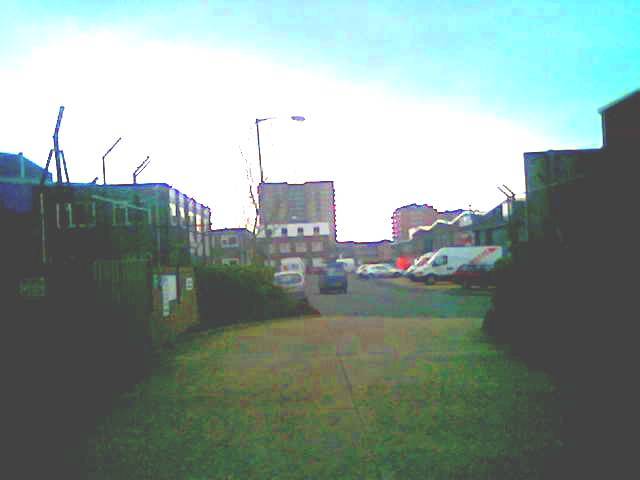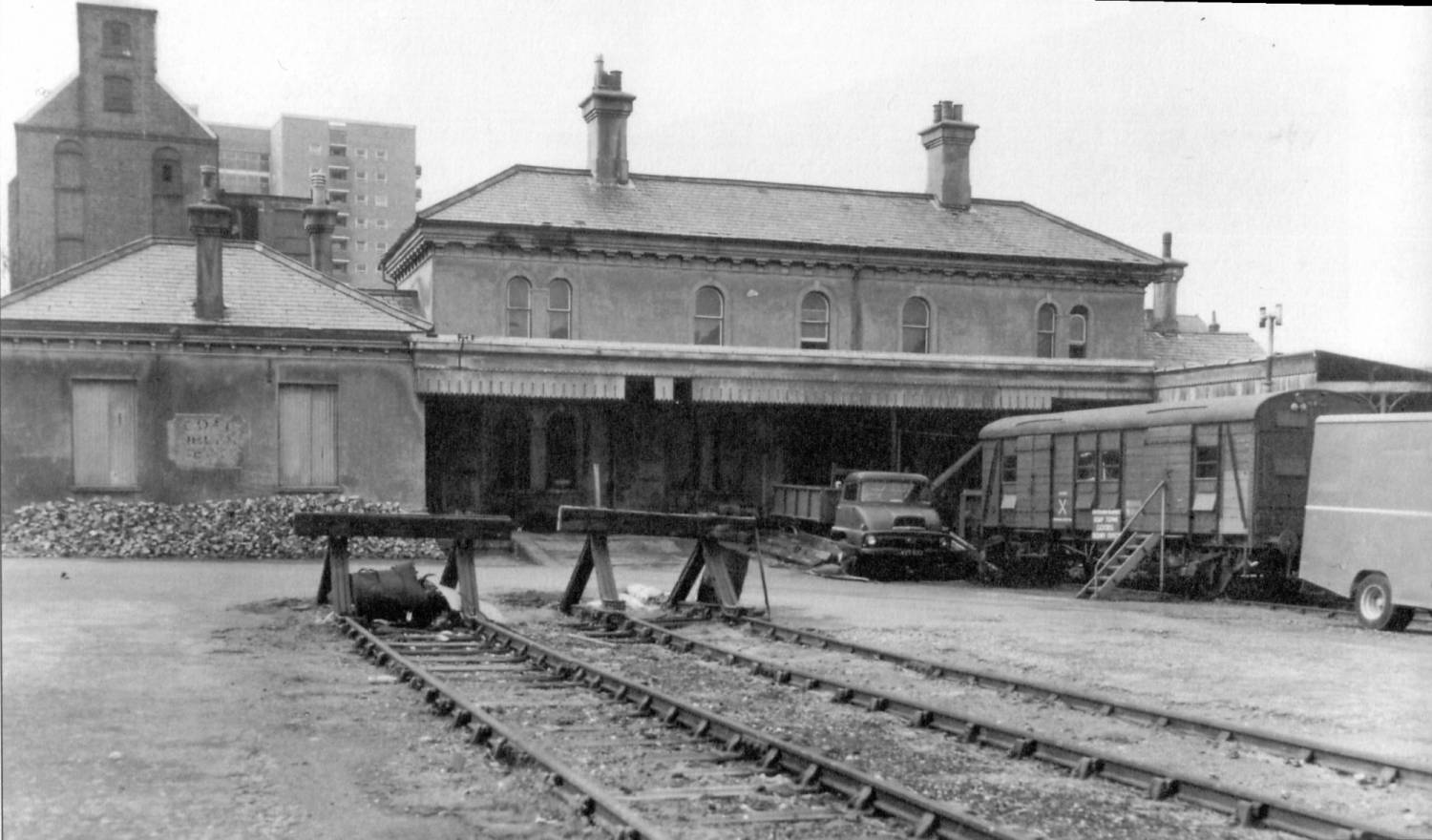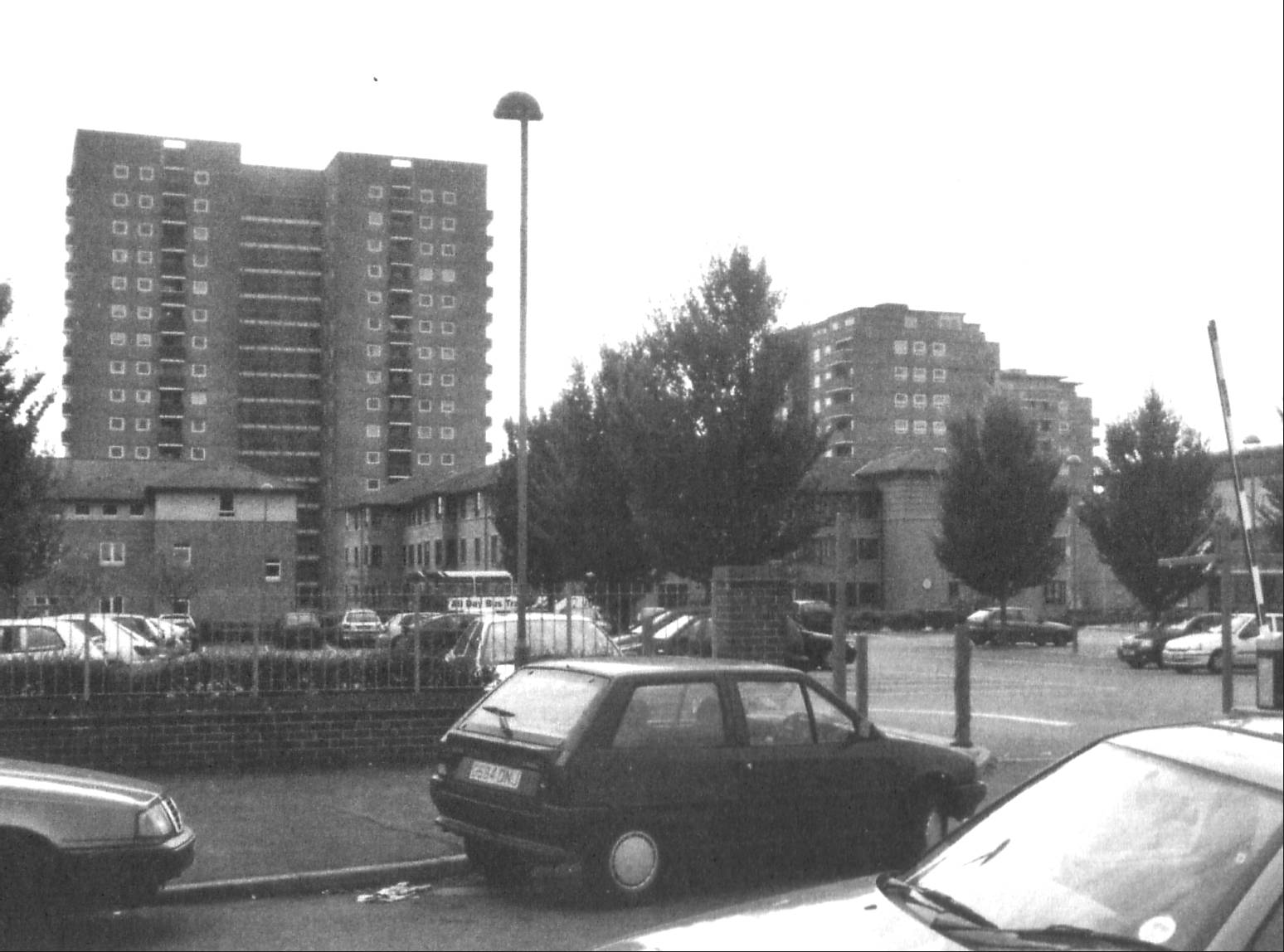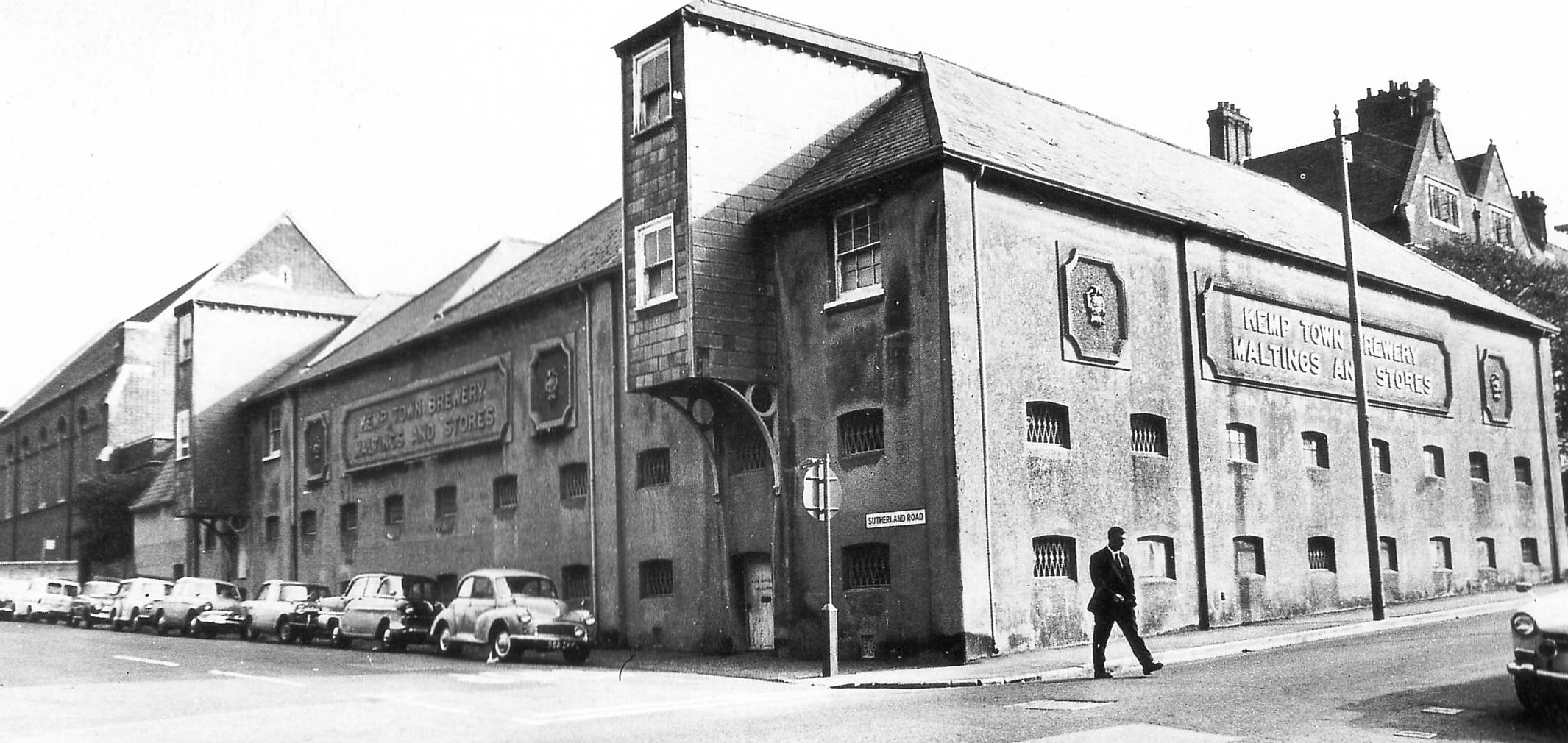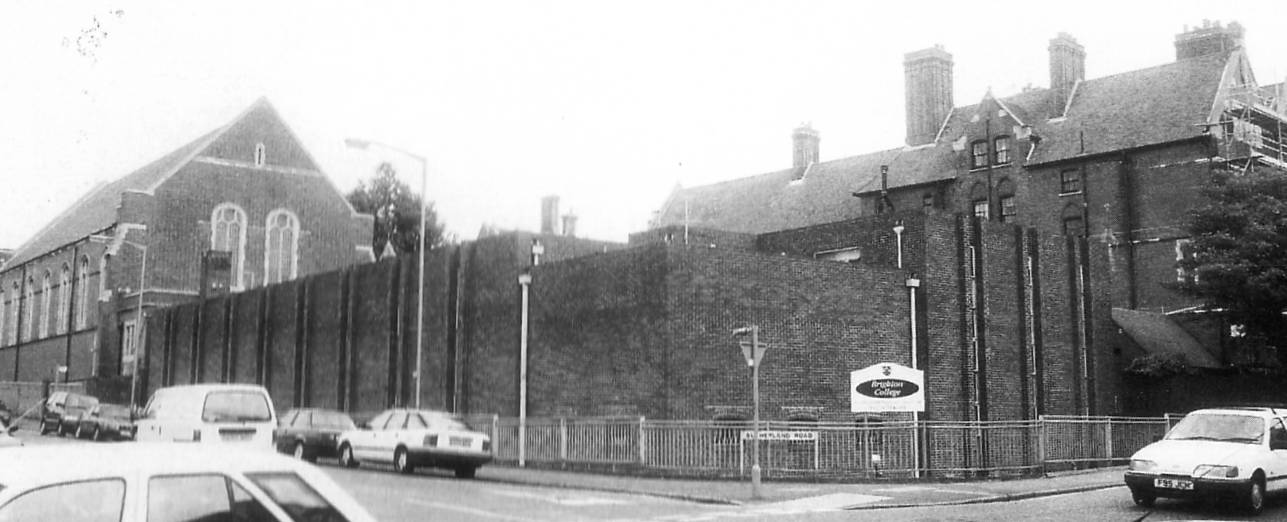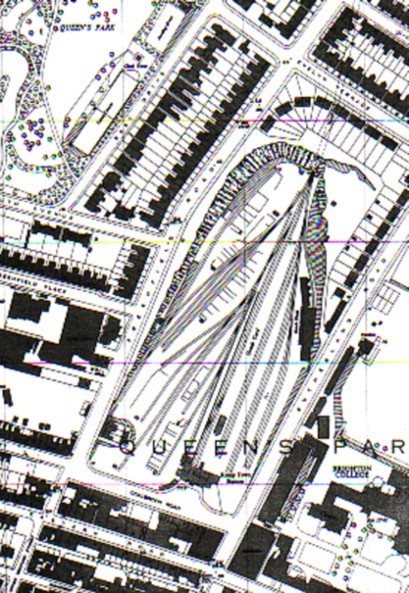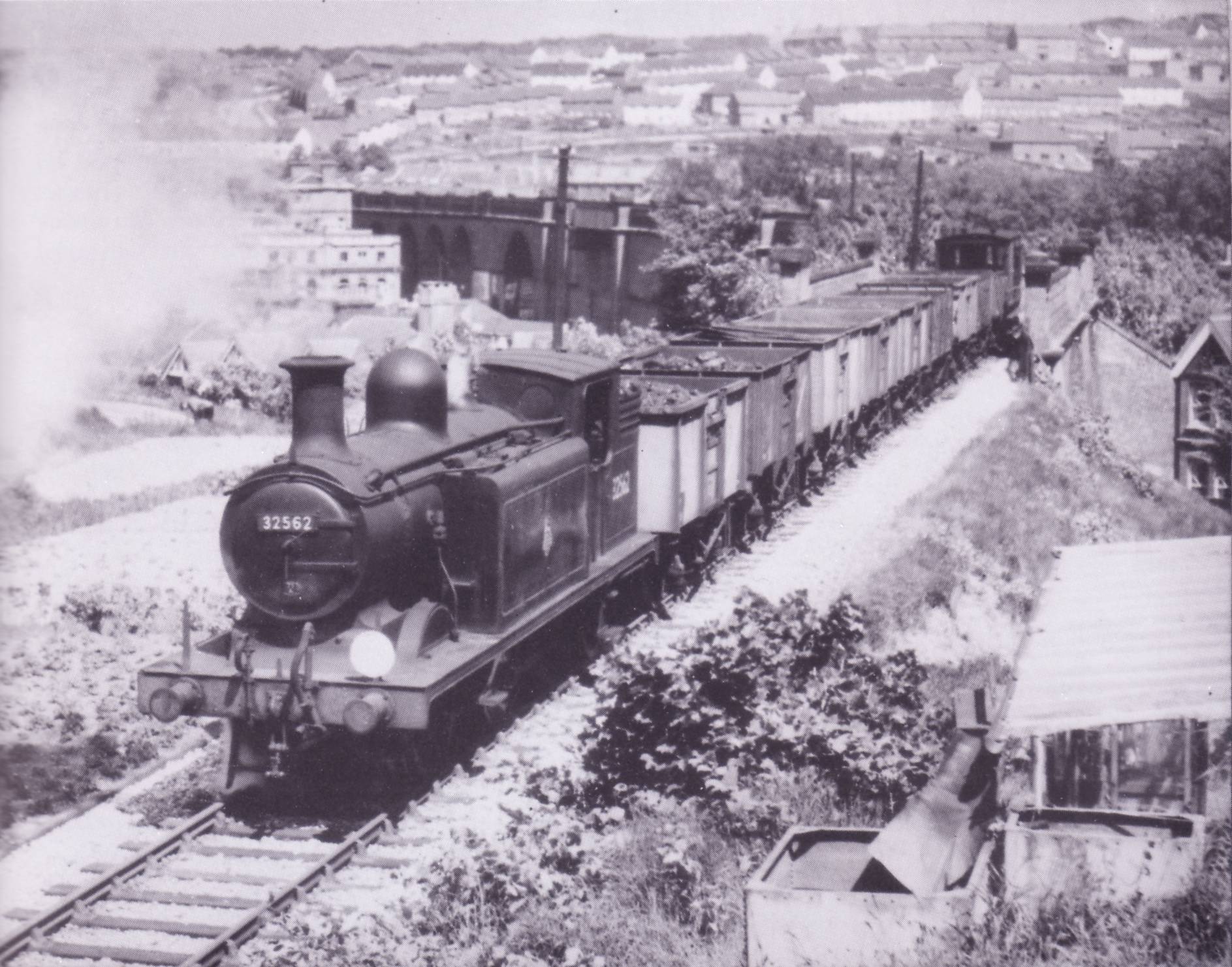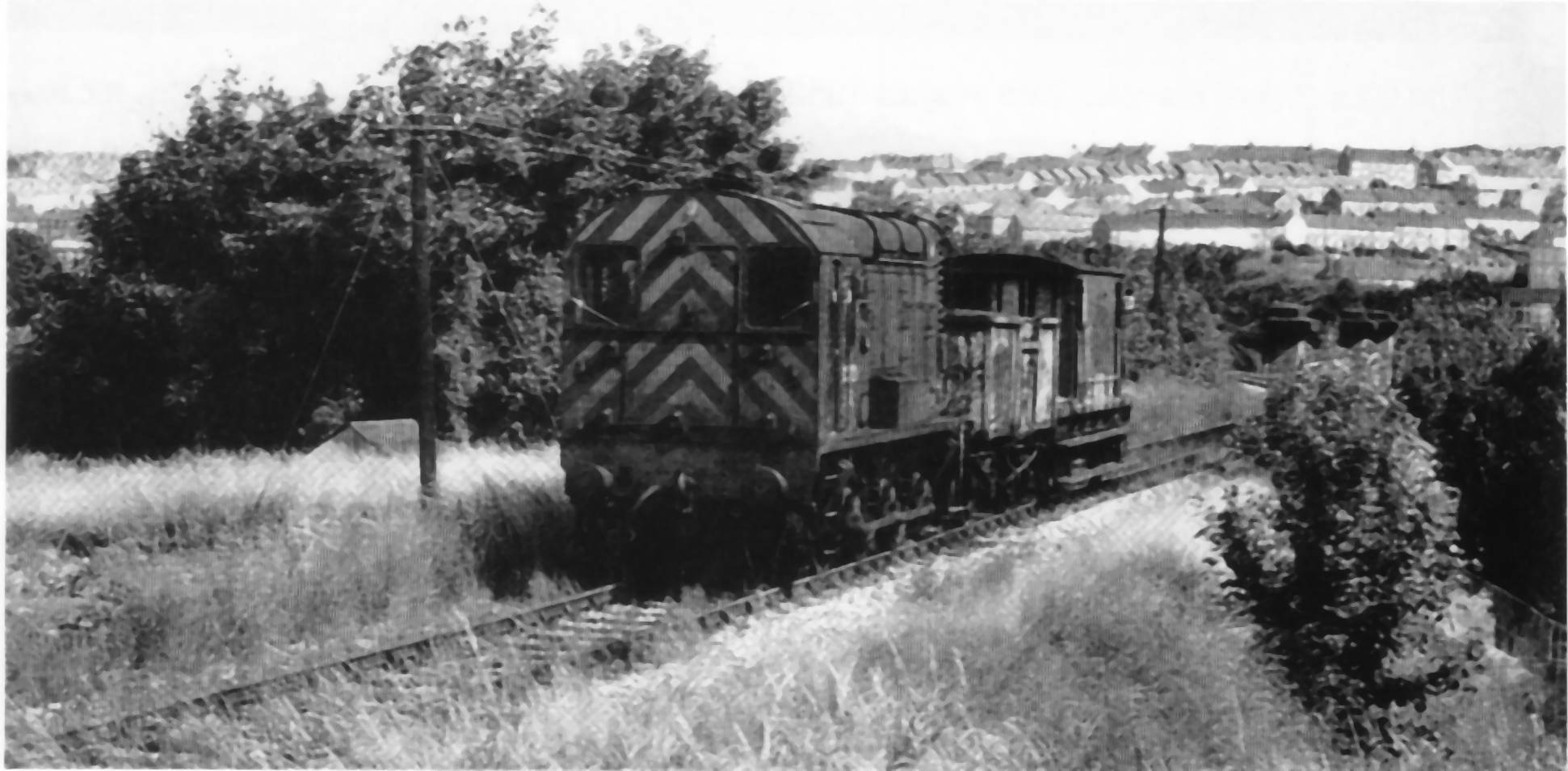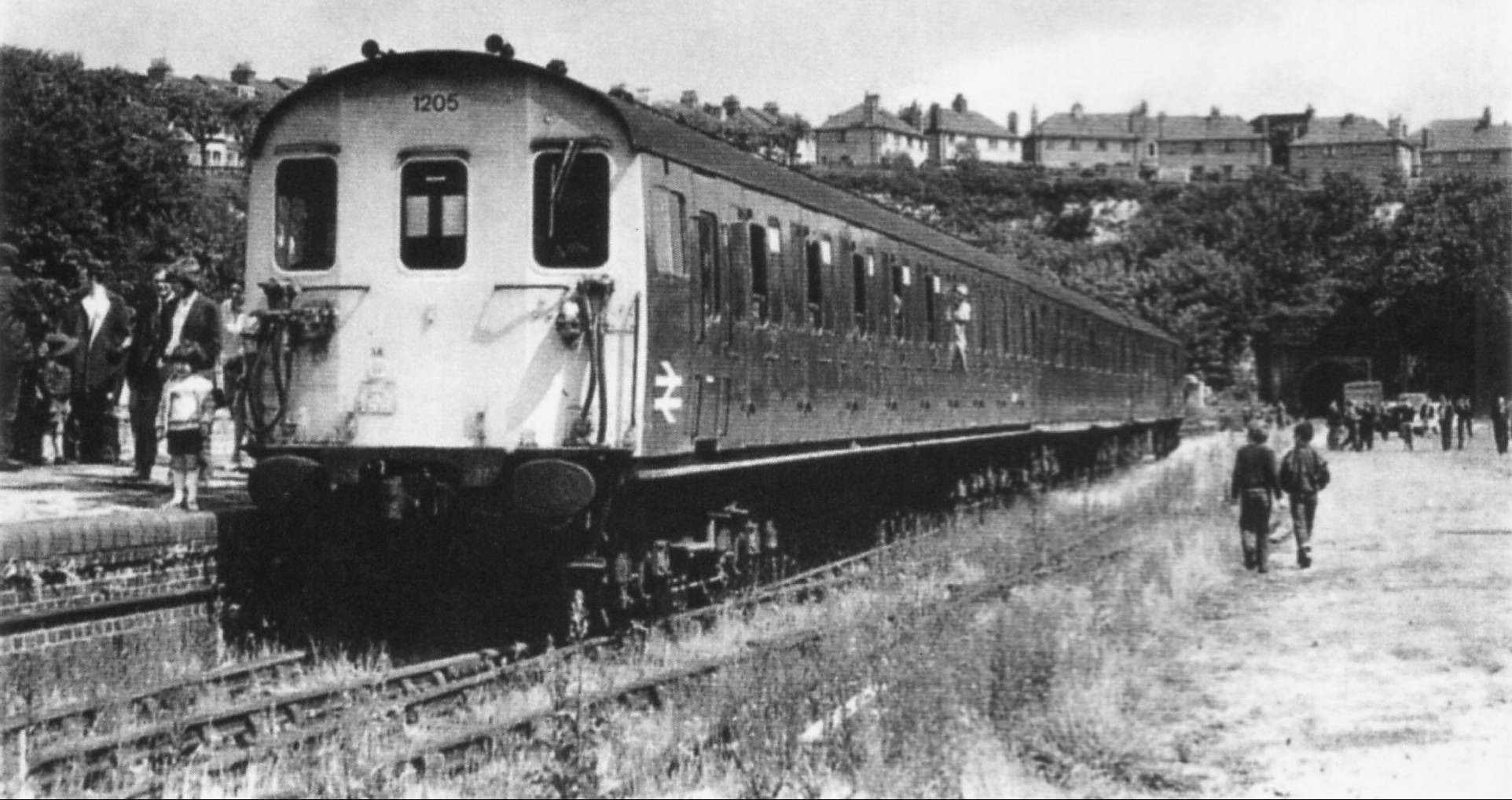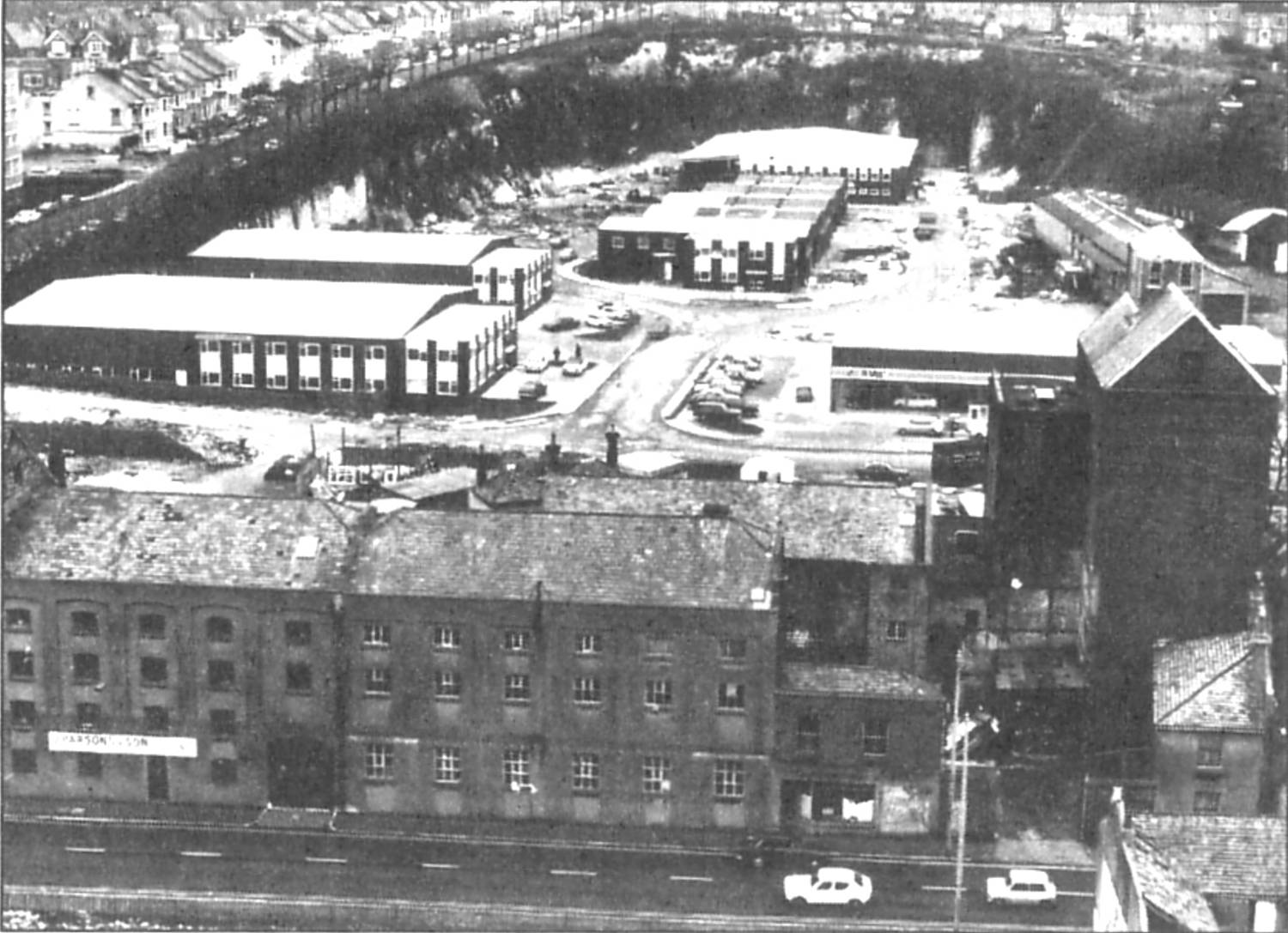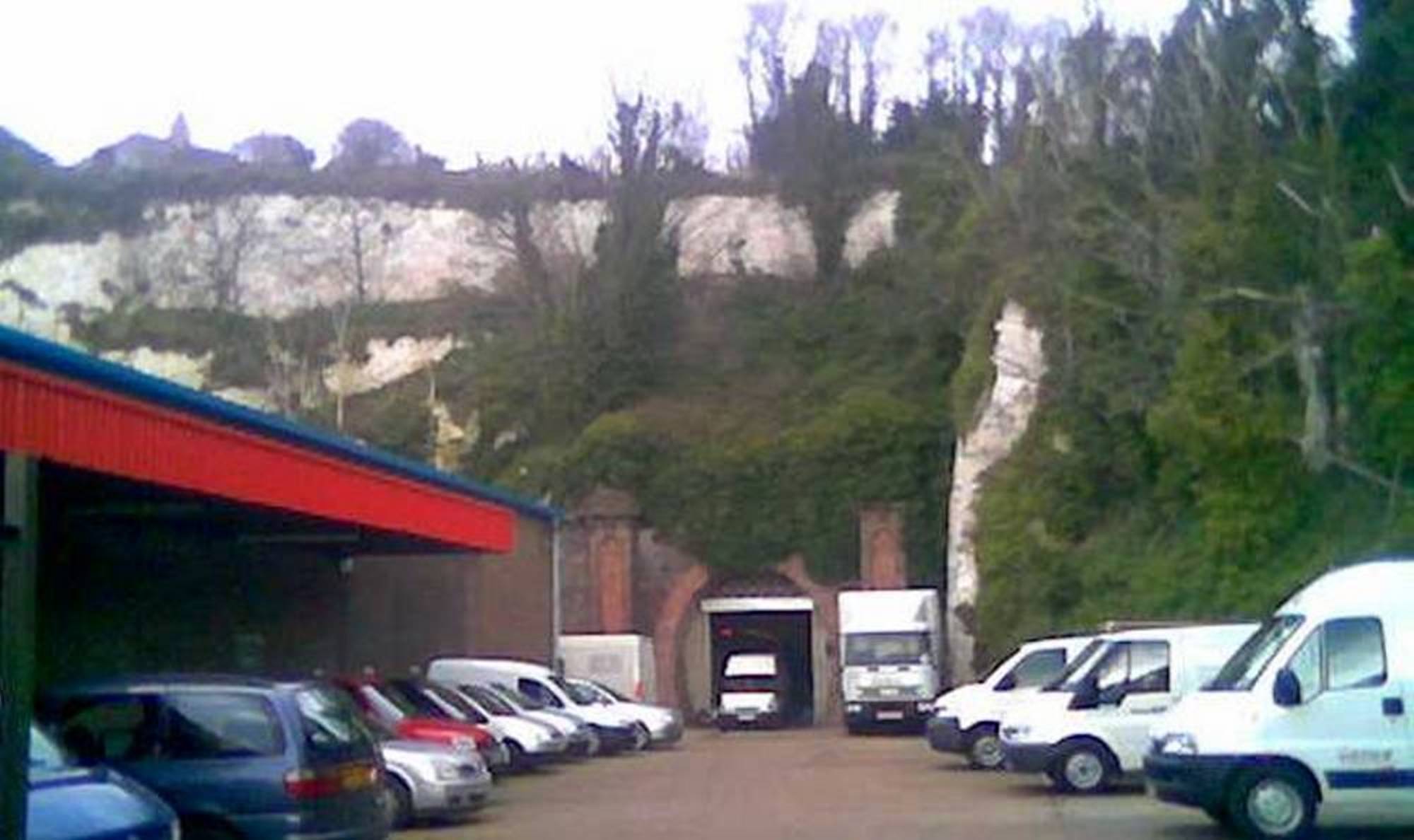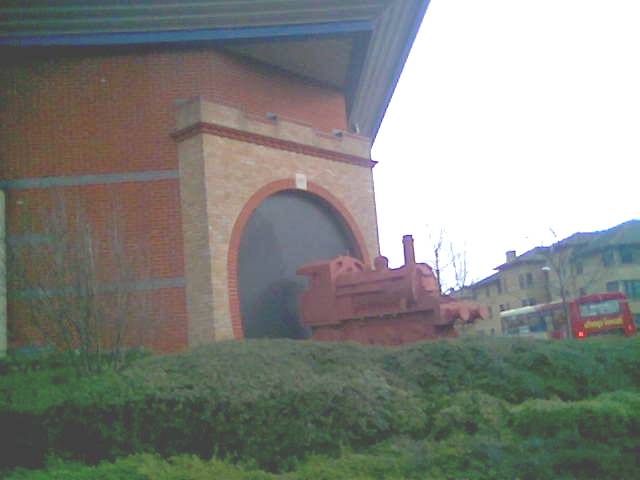KEMPTOWN STATION & THE GOODS YARD
So far, we have covered the Lewes Road and Hollingdean aspect of the Kemptown Railway, but what do we know of the actual “business end”?
Well, we know that the 1 ¼mile long branch line was opened on the 2nd August 1869 and crossed a 14 span viaduct over Lewes Road, a bridge over Hartington Road and finally disappeared into a 1024 yard long tunnel under the majority of East Brighton. But what next?

“As the small circle of light gently grows into light at the end of the tunnel, the railway breaks out into a large flat area cut into the hillside. It is bound on both sides by steadily rising chalk cliffs to the left and right and a tall curved cliff around the tunnel mouth.
The
train gently draws to a halt at a single, remarkably long platform at
the third of 5 sidings. Looking south down the platform, there is a
handsome 2-storey building, which must be the station house."
The station is shown here, old view at the top and modern day view underneath, taken from the same place
 CLICK ON THE PHOTO FOR A DESCRIPTION
CLICK ON THE PHOTO FOR A DESCRIPTION
******************************************************************************************************************************
 CLICK ON THE PHOTO FOR A DESCRIPTION
CLICK ON THE PHOTO FOR A DESCRIPTION
A close-up shot of the rear of the station building is shown here, again with the modern day shot from the same spot, underneath for comparison.
 CLICK ON THE PHOTO FOR A DESCRIPTION
CLICK ON THE PHOTO FOR A DESCRIPTION
"To the left of the station (looking south) is a large brick building, part of the Kemptown Brewery, a malthouse."
 CLICK ON THE PHOTO FOR A DESCRIPTION
CLICK ON THE PHOTO FOR A DESCRIPTION
These two photos show the Malthouse for the Kemptown Brewery, again both from the same spot and with a new and old view.
 CLICK ON THE PHOTO FOR A DESCRIPTION
CLICK ON THE PHOTO FOR A DESCRIPTION
********************************************************************************************************
"Beyond the station building is a row of tall warehouses and there are seagulls wheeling high overhead.
Walking out of the station building and turning left into Coalbrook road, one passes a small row of 3 small single storey buildings, one of which is a café. A short walk down Upper Bedford Street, past the famous Stag Inn, leads to the Seafront”.

 CLICK ON THE PHOTO FOR A DESCRIPTION
CLICK ON THE PHOTO FOR A DESCRIPTION
Kemptown station must have been a tremendously exciting place to travel to by train; it is certainly an interesting route across the town.
Not many other branch lines can boast such engineering feats in such a short length of line. The LBSCR considered the intricacies and expense to be worth it though, as the Kemp Town Railway appears to have come into existence almost purely to thwart plans by another railway company to build a rival line from London in 1863 and 1864, terminating in Eastern Brighton. This proposed line would have run from near Beckenham, via East Grinstead to Lewes, before curving round into the Kemptown area of Brighton. The plans were, thankfully, rejected by the House of Commons.
When the Kemptown branch originally opened in 1869, there were 9 trains each way and this built up to between 16 and 20 journeys a day by 1880, such was the popularity of the branch with Victorian holiday-makers!
During the line’s busiest periods there were 2 locomotives working the route between Kemptown and Brighton Station. It may be interesting to note that while the line was at its busiest with regard to passenger journeys during 1880, there were still 70 trips per day (50 with a single coach train, also 20 with a double coach train) in 1931, and 18 trains each way in 1932. This was the line’s last year of active service.
On opening in 1869, the station only had 4 sidings and a platform road. In 1873 the site of the station was extended to the final layout of 21 sidings, to incorporate a sizeable goods yard, coal sidings and a container (or con-flat) depot.
 CLICK ON THE PHOTO FOR A DESCRIPTION
CLICK ON THE PHOTO FOR A DESCRIPTION
A few of the western sidings and outbuildings were removed around 1933 bringing the number of sidings back to 19, but few other changes were made until closure. The station building on the site is a standard design, which appears at many other stations around Brighton and Hove, bearing more than passing similarities to London Road, Portslade & Hove Stations. As the branch was single line between Lewes Road viaduct and Kemptown Station, it transpires that one of the most remarkable parts of the Station layout is an enormously intricate 4-way point directly outside of the tunnel mouth.
 CLICK ON THE PHOTO FOR A DESCRIPTION
CLICK ON THE PHOTO FOR A DESCRIPTION
Looking towards the tunnel mouth, a small signal box would have stood to the left of the portal (this was eventually removed around July 1933), controlling the main lines and sidings to the platform and main station area.
There would have been a small headshunt (a small length of track on which a loco may be positioned so as not to foul points changed during shunting) on either side of the tunnel portal. One of these was removed in the 60’s.
One of the most enchanting aspects of the station is that residential properties encroach onto the yard in the south-west corner, giving the site a truly suburban feel. There are also houses around the perimeter of the site in Sutherland Road and also above the tunnel portal in Evelyn Terrace. The perimeter of the site on both Sutherland Road and Freshfield Road were littered with small business premises due to their easy access and proximity to the goods yard. Sadly, none exist today and the site is hemmed in on these two sides by trees and bushes.
The station, apart from being close to the seafront and beach, is also very close to Queen’s Park and The Race Course, which would have made it very popular with Victorian day-trippers. Brighton College is right next door to the station, although I suspect this would have catered very little for additional traffic on the branch.
During the branch’s heyday, a regular flow of goods would have arrived at the station for the nearby flour mill and the Kemptown Brewery. Associated Biscuit Manufacturers also had their depot based at Kemptown around 1935 and as this was their main distribution centre for most of Sussex (operating mostly from the site’s old goods shed), this catered for a large proportion of the line’s workload.
Charringtons took over the Kemptown brewery in 1954 and continued to add to the branch traffic until 1964, when the company’s operations were moved to newer and larger premises in Newhaven. All of the Brewery buildings were demolished in 1970-71. In a similar move, the nearby flour mills were closed in around 1923.
The line was eventually closed to passengers in 1933 and once there was no traffic through for the brewery or the mill, the line was used mostly to handle coal and bulky aggregates e.g.: pitch for the nearby corporation depot.
Goods traffic continued after 1933 but from 29th July of that year, the Kemptown branch ceased to work as a line in its own right and instead became little more than one long siding, basically a continuation of Brighton Station’s upper goods yard. At this time, the Kemptown line had just one engine in steam on shunting duties.
 CLICK ON THE PHOTO FOR A DESCRIPTION
CLICK ON THE PHOTO FOR A DESCRIPTION
Coal traffic continued to serve the depots at Lewes Road and Kemptown, but on 26th June of that year, all Coal operations were moved to a site in Hove, which still stands today as the Corals yard, just north-west of Hove Station and adjoining Sackville Road.
The Kemptown Railway valiantly struggled on. At the lowest ebb of activity, the sole traffic consisted of a daily goods train consisting of one flat bed truck, a single goods van and a brake van, a sorry departure from its glorious past.
 CLICK ON THE PHOTO FOR A DESCRIPTION
CLICK ON THE PHOTO FOR A DESCRIPTION
A mild reprieve came about during the 1950’s and 60’s when the railway became very popular with various railway enthusiasts societies.
Two such notable events were arranged by the Railway Correspondence and Travel Society on 5th and 19th October 1952, to commemorate the centenary of The Brighton Works.
On
the 26th June 1971, Kemptown station closed its doors for the very last
time, but not before going out in real style. One last, very special
passenger train was commissioned to run on the line in the unlikely
guise of a class 206 DEMU no.1205, to give rail enthusiasts one last
chance to travel on the line and to say their farewells. The last train
is described in detail on the page "Nick Phillips remembers the Last
Train to Kemp Town".
 CLICK ON THE PHOTO FOR A DESCRIPTION
CLICK ON THE PHOTO FOR A DESCRIPTION
Kemptown Station, the Goods yard and the surrounding area were gradually cleared from the 1960’s onwards, although the goods yard and station site were not notably changed until the late 1970’s. Edward Street was widened right up until the junction with Sutherland Road in the 1960’s, so many of the surrounding warehouses were removed in the course of these developments.
 CLICK ON THE PHOTO FOR A DESCRIPTION
CLICK ON THE PHOTO FOR A DESCRIPTION
However, due to Brighton College being a listed building and most of the surrounding area being largely residential, Edward Street could not be widened beyond this point and generates a messy and convoluted bottleneck into or out of Brighton.
There were a few interesting but short lived ideas which came to light in the local press. The Tunnel presented a useful opportunity to bypass just about every awkward traffic junction in East Brighton (and heaven knows there are plenty of them!) and one particularly notable idea would have seen a road built through the tunnel. Unfortunately, the tunnel was not wide or tall enough to cater for buses or goods vehicles or even two lanes of traffic and so this particular idea was quashed in its infancy.
The station building proper was used briefly as a coal office and also Len’s café (to the left of the frontage) continued to trade for a short while after closure. The goods yard was cleared and converted into an industrial estate in 1975, as was the eventual fate of most goods yards across the rail network.
As has been mentioned, the actual station building remained intact, albeit boarded up and gently decaying until the early 1990’s when it was cleared along with the remains of the warehouses facing it. The warehouses site would become various blocks of sheltered flats for the South Downs Housing Association, Jacqueline Du Pre, Evelyn Glennie and Cello Courts and other nondescript blocks, an unnecessarily wide paved area and another awkward road junction.
The old Kemptown Brewery’s malthouse, which stood on the corned of Sutherland Road and Eastern Road, was demolished in 1971 and replaced by the horrible, architecturally bland Woolton Building, which is part of the adjoining Brighton College. Happily, the Woolton Building is in process of being expanded and modernised at the time of writing (February 2008).
The Kemptown Tunnel, as has been described in the Lewes Road Area section, had its western end bricked up and landscaped as part of William Clark Park, but the Eastern end is still open in the present day. For a while it was used as a mushroom farm with dark, damp conditions within the tunnel proving ideal for mushroom growing. In recent years it has been used as storage space by Brighton Van Rentals, and most recently as secure public storage space by "Storage King".
 CLICK ON THE PHOTO FOR A DESCRIPTION
CLICK ON THE PHOTO FOR A DESCRIPTION
The Gala Bingo Hall was opened on the corner of Freshfield Road and Eastern Road in the late 1990’s and the station building site is today occupied by the Gala Bingo Car Park and the Nissan Car Showrooms behind it.
 CLICK ON THE PHOTO FOR A DESCRIPTION
CLICK ON THE PHOTO FOR A DESCRIPTION
There is nothing in the area which hints of what the site once was, save for a brick representation of a tunnel mouth on the corner of the Gala Building and a curious little concrete locomotive just in front of the portal.
 CLICK ON THE PHOTO FOR A DESCRIPTION
CLICK ON THE PHOTO FOR A DESCRIPTION


 CLICK ON THE PHOTO FOR A DESCRIPTION
CLICK ON THE PHOTO FOR A DESCRIPTION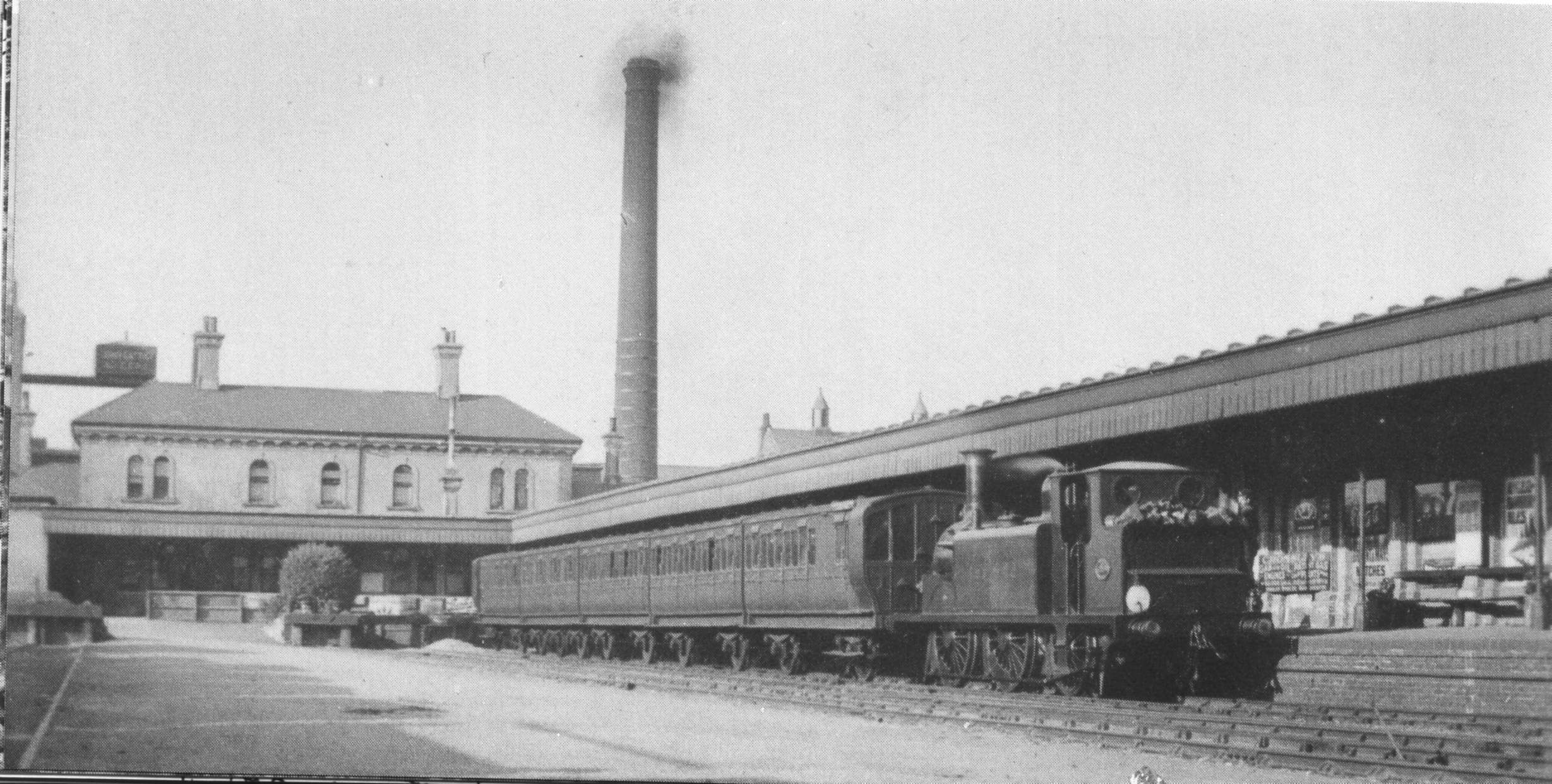
 CLICK ON THE PHOTO FOR A DESCRIPTION
CLICK ON THE PHOTO FOR A DESCRIPTION